"Landscape" is a deeply rooted, wide-ranging and distinctive category in Chinese culture, which is at the core of many fields such as literature, art, philosophy, religion, geography and architecture. In particular, the landscape painting since the Song and Yuan dynasties is recognized as a true artistic model, representing the Chinese understanding and expression of nature. However, with the rapid development of archaeological work in China, more examples of early landscape art were presented to people, and artifacts, stone mural images and so on were brought into the research vision of scholars.
Professor Wu Hong is about to publish his new book "The Time between Heaven and Man: Mountains and Rivers in the Archaeological Art Vision" in Sanlian Bookstore, focusing on the "mountains and rivers" in visual form. With the new archaeological discoveries in chronological order, he reconsiders the origin and early development of Chinese landscape painting, and outlines the formation process of "mountains and rivers" as an art tradition from scratch.
On March 3, 2024, Wu Hong, Peng Feng, Zheng Yan, Li Meitian, Qu Jingdong, and Huang Xiaofeng, six scholars from the history of painting and archaeology, launched an in-depth dialogue around the topic of landscape as a visual image, breaking the boundaries of disciplines, with the theme of "landscape as a medium - the meeting of painting history and archaeology" at the University of Chicago Beijing Center, Discuss the rich connotation and significance change of landscape in Chinese cultural and artistic tradition.
Sullivan's pioneering work
In 1954, the Cleveland Museum of Art in the United States, rich in the collection of ancient Chinese paintings, organized a large-scale exhibition entitled "Chinese Landscape Painting". Sherman E. Lee, director of the Oriental Department of the museum, also published a book that is also an exhibition catalogue. At that time, it was a rare overview of Chinese landscape art written in English, so it was very popular. Art Journal, an authoritative publication of the College Art Association, called it "a commendable demonstration of the principles of Chinese landscape painting" in the book review published the following year. Encouraged by this, Li Xueman, who had been promoted to curator at that time, enriched and revised the original book and launched a new version in 1962, which explicitly wrote:
Landscape is a great subject in Chinese painting. Westerners may be surprised at the early maturity of Chinese landscape painting. At that time, that is, from the 9th to the 10th century, there was no special art form to express scenery in Europe. However, if we go back to the Mediterranean world in the Hellenistic era, we can actually find creative and forward-looking western landscape paintings. More importantly, some of the masterpieces, such as the landscape depicted in the Odyssey fresco now in the Vatican Museum, have reached a very high artistic level, which is incomparable to the oriental art of the same period
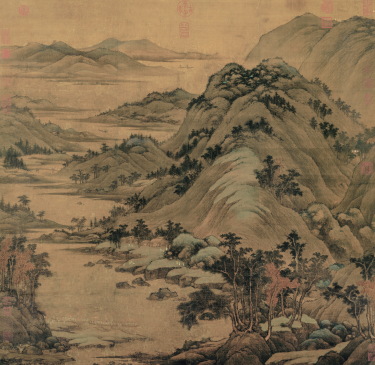 (Biography) Dong Yuan's "The Painting of Dragon Dwelling in the Countryside", collected by the Palace Museum in Taipei
(Biography) Dong Yuan's "The Painting of Dragon Dwelling in the Countryside", collected by the Palace Museum in Taipei By putting the "landscape painting" or "landscape painting" in the history of Eastern and Western art into the same historical chronology, Li Xueman can point out the non overlapping time clues of their birth and development. But he did not go further on this topic.
Li Xueman set the maturity period of Chinese landscape painting as the 9th to 10th century, because it was only at this time that nature was "fully represented for the first time" in East Asia. This view is not completely wrong today. The problem is that he classified the previous performance of Chinese art on mountains and rivers as the "prehistoric" period of landscape art, leaving only a few "pitiful" works. Therefore, his book is only one and a half pages long from the Eastern Zhou Dynasty to the Han Dynasty. After the other three pages, the reader has been brought to the Song Dynasty to face the famous works of Juran and Guo Xi. Obviously, in Li Xueman's understanding, the "real" landscape art in ancient China basically began in the Song Dynasty.
This view was strongly challenged by the British art historian Sullivan several years later: his first monograph, entitled The Birth of Chinese Landscape Painting, published in 1962, covered exactly the period omitted by Li Xueman. In this book, Sullivan discusses the Han Dynasty with 70 pages and the Six Dynasties with the following 70 pages, which is a fairly systematic integration of the visual and documentary materials related to natural performance in these hundreds of years.
One of the great achievements of this book is to collect a considerable amount of archaeological and physical evidence before the Tang Dynasty, and to provide the first monograph to study the early natural images of China in combination with the reference to ancient documents. More importantly, although Sullivan did not explicitly state in the book, he expanded the scope of discussion from the narrow sense of "landscape painting" to the broad sense of "landscape art", which includes the visual expression of nature in any medium, including the patterns on bronze and pottery, as well as the images in stone carvings and murals. However, this book is still subject to the limitation of the time of art history research at that time: it was written in the late 1950s, and its objects and images are mainly from the collections of the Western Art Museum and the limited archaeological books published before this time. In terms of research methods, Sullivan's main analysis strategy is to extract the motifs of mountains, trees, grass leaves and other portraits in the Han Dynasty and the Six Dynasties from these materials, classify them into different forms and observe their development. Influenced by the prevailing style evolution in the study of western art history at that time, he believed that although these images reflected some local styles and external influences, the most important thing was to show the evolution process of "gradually turning from abstract to naturalistic style".
Since the publication of this groundbreaking monograph, it has been a whole year. During this period, with the great progress of archaeological work in China, more examples of early landscape art were presented to people. Many scholars have studied these examples from various perspectives, and their academic achievements have been constantly introduced and used in the above chapters. From the perspective of the continuity of academic development, The Time between Heaven and Man: Landscape in the View of Archaeological Art is another monograph with the title of early landscape art after Sullivan's pioneering work. Its coverage period roughly coincides with Sullivan's two pioneering works, The Birth of Chinese Landscape Painting and Chinese Landscape Painting in the Sui and Tang Dynasties, He also continued his efforts in accumulating and using new materials.
However, in terms of the understanding of archaeological evidence and the analysis method of image data, The Time between Heaven and Man is obviously different from Sullivan's works. One of the most basic differences, as mentioned in the preface, is that Sullivan dissolved archeology and material objects into a separate "motif", such as rocks, trees, grass leaves, water waves, etc., based on which to observe and reconstruct the occurrence and development of ancient Chinese landscape art. However, the "landscape image" defined in "The Moment between Heaven and Man" is a composition that integrates many motifs and is a picture space as a visual expression. From the sacred mountain images on engraved bronze wares discussed in the first chapter, to the fairy mountain landscape and human world in murals, stone carvings and artifacts discussed in the second and third chapters, to the "pseudo landscape paintings" and related scroll paintings discussed in the last two chapters, these landscape images are two-dimensional or three-dimensional complete visual expressions with the theme of nature, and have specific cultural and ideological connotations. Therefore, when discussing the origin and development of landscape art, the first step is to explore these self-contained visual expressions, and then explore their connotation and regularity.
There are two other differences between "The Time between Heaven and Man" and Sullivan's works. First, there are different understandings of the evidence value of archaeological art materials: in addition to being the source of landscape images, this book believes that these materials also provide a variety of other important information related to early landscape art. Second, there are different understandings of the development process of "early Chinese landscape art": instead of viewing this process as linear formal evolution, this book believes that it reflects the increasingly rich cultural and ideological connotation and increasingly complex sociality of landscape art. In general, if Sullivan successfully incorporated archaeological materials into the study of traditional art history half a century ago, the purpose of When the Heaven and Man Are Together is to break through the disciplinary boundaries of traditional art history under the concept of "archaeological art" and rethink the content and development process of China's early landscape art.
Thinking about "Archaeological Art"
This purpose leads us to think more deeply about the concept of "archaeological art". In the preface to the book, "Archaeological Art" has two basic meanings at the methodological level. On the one hand, it refers to the type and nature of research materials, and on the other hand, it relates to the methods of analyzing and interpreting materials. As far as materials are concerned, the evidence used by "archaeological art" mainly comes from underground archaeological discoveries and ground sites, supplemented by handed down objects and documents. In terms of research methods, "Archaeological Fine Arts" analyzes and interprets research materials within the discipline framework of art history. Based on works and images, it discusses their themes, styles, media materials, original environment, origins and other issues, and goes deeper into artists, sponsors, aesthetic standards and other more delicate levels when data allows. The main difference between "archaeological art" and other types of art history research lies in its close interaction with archaeology, which is not only reflected in the massive use of archaeological resources, but also shows the absorption and integration of archaeological observation angles and research methods. The study of "archaeological art" in these two senses actually means "the history of archaeological art", which is a part of the discipline of art history.
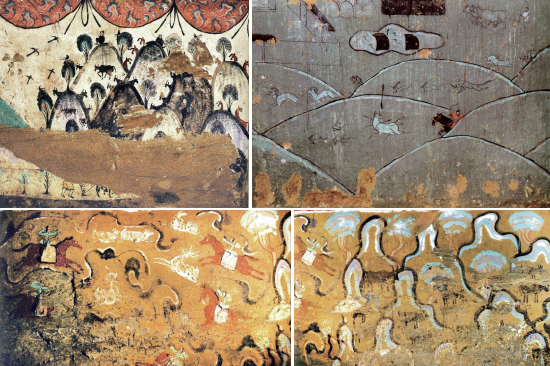 The human mountains and rivers in the mural tombs of the Eastern Han Dynasty, the late Eastern Han Dynasty
The human mountains and rivers in the mural tombs of the Eastern Han Dynasty, the late Eastern Han Dynasty The scope of "Archaeological Art" is extremely broad. It can not only consider its disciplinary characteristics as an independent field of art history, but also involve many other fields in art history. This is because these fields can and have used archaeological materials and interacted with archaeology at the above two levels. From this point of view, although "archaeological art" has the most direct significance to early art research, it is not limited to a particular historical period in fact - just think about the role of the excavation of Jingdezhen porcelain kiln site in ceramic art research or the contribution of underwater archaeology to the "global history of art", people can immediately realize "archaeological art" The scope and function of the art history is far beyond prehistory, the three dynasties, the Han and Tang dynasties, and even beyond the national art history narrative.
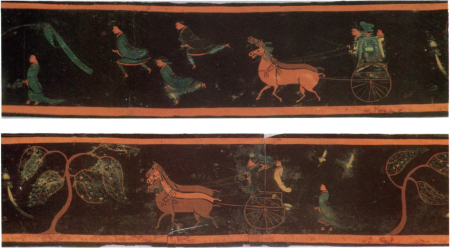 The painting of horses and chariots on the lacquer box of the portrait unearthed from Tomb 2 in Baoshan, Hubei
The painting of horses and chariots on the lacquer box of the portrait unearthed from Tomb 2 in Baoshan, Hubei One of the importance of "Archaeological Art" is that it reflects a key feature of academic research on contemporary Chinese art history. Due to the vigorous development of Chinese archaeology in the past 30 to 40 years, art history scholars are increasingly using new materials in different fields and interacting closely with the archaeological community. This interaction is very prominent in the global art history circle. Some important areas of Chinese art history, such as the study of ancient bronzes, jades and lacquerware, the study of Han portraits, and the study of Buddhist grotto temples, have all been deeply combined with archaeological excavation, investigation, classification and staging, and have also developed a unique perspective and analysis approach to art history.
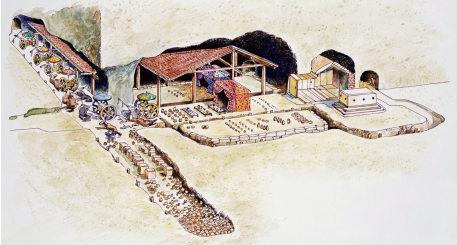 Restoration drawing of the architectural structure of Liu Sheng's tomb (Mancheng No.1 tomb), King of Zhongshan
Restoration drawing of the architectural structure of Liu Sheng's tomb (Mancheng No.1 tomb), King of Zhongshan The recent emergence of "Tomb Art Research" has more strongly demonstrated the potential of this academic direction, because this new research field is not formulated based on the classification framework of western art history, but is aimed at an extremely important inherent part of Chinese art and visual culture: Tomb is the oldest and most deeply rooted architectural and art tradition in China, No matter in the duration of time or in the extension of region, it is unparalleled in the world art history. It is also a comprehensive system with the richest archaeological information, including architecture, artifacts, painting, sculpture, decoration, burial tools, engraved calligraphy and the burial of the dead. Through exploring and sorting out these materials and exploring the corresponding research methods and concepts, the researchers of tomb art have carried out many individual cases and macro research projects, gradually opening up the field of art history research and teaching of "tomb art", and also providing new content and thinking angle for art history research and education worldwide. From the broader perspective of "archaeological art", burial art is not only a component of archaeological art, but also a cornerstone for further development of archaeological art research methods.
Li Meitian, a professor of the Department of Archaeology and Museum at the School of History of Renmin University of China, said, "Archaeological art is different from art archaeology. The foothold is in the history of art. The tradition of landscape painting has been firmly established in the Five Dynasties. Before the Five Dynasties, we actually did not have much information, and the information of handed down landscape painting is very lacking. Thanks to archaeology, archaeology, like other subjects, can always bring us some surprises. The information about landscape images accumulated over the years has been very rich. Teacher Wu has made a good sorting and arrangement of landscape information from the Warring States Period to the Tang Dynasty. " At the same time, Li Meitian stressed that "the concept of archaeological art is very meaningful for art writing. In addition, how can we do archaeological art research? Its characteristics, in addition to materials, are called archeology because the original environment of materials, whether figure paintings, landscapes or artifacts, cannot be separated from the original environment of archeology. It must have an internal logical connection with the tomb buildings, the furnishings and images in the tomb, rather than understanding images as isolated images, Only in this way can we get a more realistic interpretation close to history. "
Landscape art is not just landscape
As an independent research project, The Moment between Heaven and Man uses a lot of materials related to tomb art, but what it attempts is another entry point in archaeological art, that is, through the research on the early development of Chinese landscape art, to explore the relationship between archaeological art and painting history. Professor Wu Hong said that, "Landscape art is a very important issue. It is not only important for the history of painting, but also for various categories, including literary history, landscape poetry, and philosophy history. We mainly study images, as well as sculpture, which is the visual landscape. The creation and initial development of mountains and waters from the beginning to the establishment of mountain and water art as an important art tradition in China is the creation and initial development of mountains and waters."
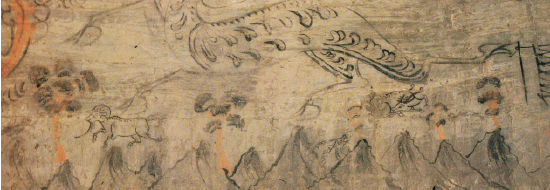 Detail of the mountain at the bottom of the top of the front chamber of No. 5 Tomb in Dingjiazha, Jiuquan, Gansu
Detail of the mountain at the bottom of the top of the front chamber of No. 5 Tomb in Dingjiazha, Jiuquan, Gansu These contact methods are not static, but constantly changing according to the special circumstances of different historical periods. In fact, the most important fact revealed by the overall narrative of "Between Heaven and Man" is that the history of early landscape art is a process of continuous development and change. The landscape images and their carriers in each period, as well as their ideological connotation and cultural environment, are constantly changing. As a result, the function of archaeological materials for historical research and the contact point between archaeological art and painting history are also changing.
Huang Xiaofeng, a professor at the Humanities Institute of the Central Academy of Fine Arts, believes that "Mr. Wu Hong skillfully integrated the history of landscape painting into the six chapters. Although the title does not use the subtitle of" early landscape history ", it is called" landscape in the perspective of archaeological art ", but it has a historical context. The six chapters have different themes, which are not only related to archaeology, but also to the research of art history, aesthetics and other different periods. I think it's a wonderful structure. "
The combination of these studies of archaeological art and painting history serves a common purpose in the book, that is, to re understand the history of early Chinese landscape art. But what kind of history is this—— This problem arises because the discipline of art history has produced different academic traditions in its development process, and has quite different understandings of the nature and connotation of art history. The formalist school regards the process of art as a purely formal evolution or the evolution of visual ways. In recent decades, the more dominant view has seen art as an important part of human thought, culture and society, developing and changing in the interaction with literature, music, philosophy, religion and other aspects. The latter point of view is clearly adopted in The Moment between Heaven and Man, which regards image analysis as a necessary way to explore the evolution of ideas and aesthetics, and also obtains a deeper understanding of image forms.
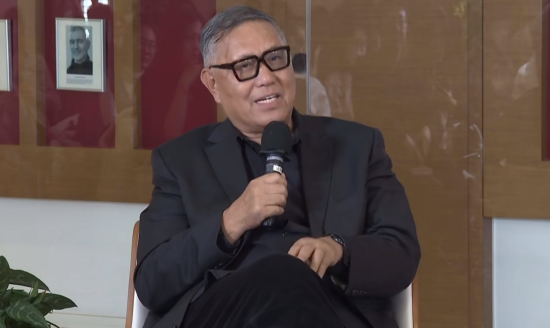 This book is written by Wu Hong, professor of art history at the University of Chicago
This book is written by Wu Hong, professor of art history at the University of Chicago As Professor Wu Hong said, "Mountains and waters in China are not really mountains and waters, but have strong philosophical, spiritual and cosmological significance. They often connect heaven and earth, gods and people, and connect different directions. China has Chinese landscape art tradition, Rome has landscape, northern Europe also has landscape, even Maya also has landscape, but they have different landscape traditions, so what is the Chinese landscape tradition? After the appearance of Chinese landscape images, how did these images further develop into a continuously evolving system of Chinese art, how was the meaning of this system recognized by people at that time, and how was it constantly consolidated from both practice and discourse. Practice is concrete, and discourse is speaking and writing. People are talking about mountains and waters as a tradition. It has not only images, but also various words. How people talked about mountains and waters at that time, how to appreciate mountains and waters, and how to communicate with mountains and waters. Together, we can understand traditions. "
Qu Jingdong, a professor in the sociology department of Peking University, said, "The first contribution of Professor Wu Hong's book is to build a very important four section pedigree from the Warring States Period to the Five Dynasties. The second key node changes and transformations are very clear where. Third, I think it is the key, which many historians failed to do. What he cares about is spiritual issues, not purely material issues, so this book is actually ideological. Archaeological art has made great contributions in this respect, and has its own clear disciplinary characteristics. Although it is not all disciplines, it cannot replace all disciplines, but it is very important. First, it closely links materiality and formality. Second, Mr. Wu Hong is also concerned about the relationship between image and system. The third great contribution is that he explored the multiple structures of Chinese civilization. "
The history of "early Chinese landscape art" thus described is not purely formal evolution, nor is it the evolution of images without subjectivity. As shown in the book, the important image types produced in each period - from the holy mountains in the Warring States Period to the immortal mountains in the Han Dynasty, from the mountains and waters as the "medium" in the Wei and Jin Dynasties to the pseudo landscape murals in the tombs of the Tang and Five Dynasties - all contain rich humanistic and social content, and also constantly innovate the forms of expression of mountains and waters. Their significance in the history of fine arts is inseparable from the comprehensive cultural environment in which they live. Only in this environment can these images have their real vitality. Peng Feng, Dean of the School of Arts of Peking University, said, "Mr. Wu Hong's works give us a very good opportunity to think about how the early Chinese people's minds were established and developed in the existing images."
This is the reason why While adhering to the principle of "starting from images", The Moment between Heaven and Man quotes a large number of contemporary historical, literary, religious and art history documents.
Wu Hong hopes that this comprehensive analysis can show the cultural ecology that makes landscape images have vitality, and at the same time, constantly create contact points for interaction with other disciplines, so as to bring archaeological art research into the multidisciplinary and interdisciplinary interactive academic relationship.
 Part of the mural "Five Hundred Bandits Becoming Buddhas" in Cave 285 of Mogao Grottoes in Dunhuang
Part of the mural "Five Hundred Bandits Becoming Buddhas" in Cave 285 of Mogao Grottoes in Dunhuang







